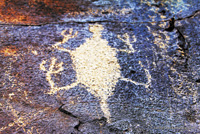Down a gravel road dense with rabbit brush and rich with bottomless pot-holes, I found some of the earliest imprints by man in North America. Where the gravel road terminated, a trail of imbricated cobbles left by a long forgotten water-way began. The trail lead to a cliff line shaped like a crescent moon partially enveloping a shallow lake. Story by Krystal Marie Collins
Straining my eyes to find the petroglyphs, it occurred to me how tragically easy it is to forget Oregon’s first artists as their work can be difficult to find.
At first, weathering made it challenging to discern the etchings from mineral deposits. Searching for the tale-tale white markings of rock art, I began to notice corroded cream color shapes carved into the lava flow. I wondered what this stone had encountered post inscription. In the Great Basin, these markings would be susceptible to freeze thaw fracturing, exfoliation through extreme temperature swings, and repeated seasonal hydrologic fluxes, nature’s ways of slowly erasing the canvas.
 Miraculously, the rock art found at the top of Hart Mountain in south central Oregon endured and survived. Most images were sights one might see in nature; turtles, antelope, insects, people and other zoological forms. Though I could decipher most carvings, it was hard to grasp the meaning of the symbols collectively. Most images were tucked away in corners where the frozen lava flow made a shallow cavern or nook in the larger rock face. A short distance from the water’s edge, one could imagine the artist in his covert scouting spot, sculpting a piece in homage to the pray he might soon entrap near the water’s edge.
Miraculously, the rock art found at the top of Hart Mountain in south central Oregon endured and survived. Most images were sights one might see in nature; turtles, antelope, insects, people and other zoological forms. Though I could decipher most carvings, it was hard to grasp the meaning of the symbols collectively. Most images were tucked away in corners where the frozen lava flow made a shallow cavern or nook in the larger rock face. A short distance from the water’s edge, one could imagine the artist in his covert scouting spot, sculpting a piece in homage to the pray he might soon entrap near the water’s edge.
Standing before one face with numerous seasons of overprints, I realized the fabrication process must have required considerably more resourcefulness and ingenuity than any art created since the industrial age. Searching out canvases on durable surfaces and preparing tools sharp enough to shape rock, to say
I was impressed by this artistic achievement would be an understatement. Even if the etchings no
longer were, one truth was clear, people of the Great Basin put out enormous efforts to express their creativity.
Ultimately, visiting a petroglyph site inspired reflection on the luxury of the 21st century, and how, despite technological advancement, it can still be hard to infuse creative process in daily activity. If these first artists could sculpt stone without the convenience of computers, cell phones, electricity or even the wheel, I wonder what of the 21s century will be durable enough to survive weathering of 12-15,000 years to come.

